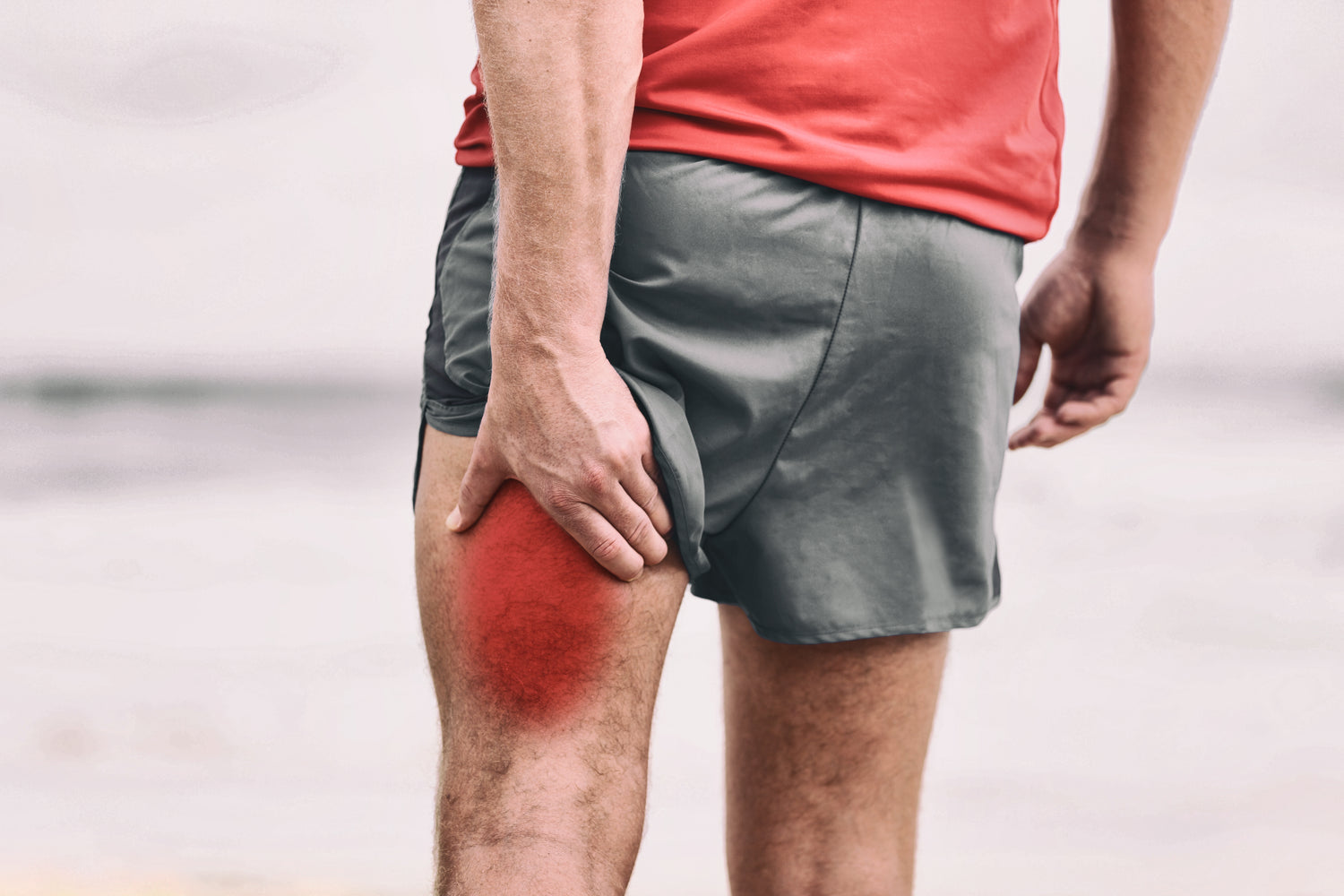Have you ever pulled your hamstring and wondered just how you could speed up its recovery time?
If yes, then you're not alone.
A pulled hamstring is a common injury, especially among athletes. It occurs when the hamstring muscles are overstretched or torn, leading to pain and swelling in the back of the thigh.
Recovering from a pulled hamstring can take anywhere from a few days to several weeks, depending on the severity of the injury. The latter can be incredibly frustrating for athletes who want to get back in the game as soon as possible.
While there is no magic cure for a pulled hamstring, there are certain things you can do to ensure faster recovery and a safe return on track. This can range from simple lifestyle changes to more intensive treatments like physical therapy.
In this article, we'll discuss some of the most effective tips for speeding up recovery time from a pulled hamstring. But first, let's look at common symptoms of a pulled hamstring.
Read on to learn more.
Common Symptoms of a Pulled Hamstring
Hamstring strains come with a painful range of symptoms that can vary in severity. Some of them include the following:
1. Sharp pain
Sharp pain is one of the most common symptoms of a pulled hamstring. It can range from a mild ache to an intense, stabbing sensation in the back of your thigh. The pain may be localized to one area or spread out over a larger area.
You may also experience tenderness and swelling in the affected area. If you have difficulty walking or running, this could be a sign that your hamstring has been strained.
2. Difficulty walking or running
If you have a pulled hamstring, it can be challenging to walk or run without experiencing pain.
You may also feel a tightness in the muscle that makes it difficult to move your leg. This is because the muscles cannot contract and relax properly due to poor flexibility.
3. Swelling
Swelling is another common symptom of a pulled hamstring.
This can range from mild to severe, depending on the severity of the injury. Swelling may be accompanied by bruising and tenderness in the affected area.
4. Muscle spasms
Muscle spasms are another common symptom of pulled hamstrings.
Symptoms can range from mild cramps to intense, painful contractions in the back of your thigh. Muscle spasms can be caused by inflammation or nerve irritation, making it difficult to move your legs.
If you experience any of these symptoms, it's essential to seek medical advice as soon as you can. Once diagnosed with a pulled hamstring, you can begin treatment to help speed up the recovery process.
In the next section, let's look at some of the most effective tips.
Speeding Up Recovery Time from a Pulled Hamstring
Speeding up recovery time from a pulled hamstring requires a combination of rest, physical therapy, and lifestyle changes.
Here are some tips to help you get back on track as soon as possible:
1. Take time to rest
Getting plenty of rest is one of the most critical steps in recovering from hamstring strains.
Resting allows your body to heal and gives it time to repair any damage done to the muscle. It also helps reduce inflammation and pain.
When resting, ensure you keep your leg above heart level as much as possible. This will help reduce swelling and promote healing.
Additionally, try to avoid any activities that may make your injury worse. If you must move around, use crutches or a cane to help support your weight.
2. Apply ice or a cold compress to reduce swelling and inflammation
Applying ice to the injured area can help reduce swelling and pain.
Ice should be applied for 15-20 minutes several times a day. Make sure you wrap the ice in a towel or cloth before applying it to your skin to avoid further damage.
Ice can also be used with other treatments, such as physical therapy or massage. If you're using ice in combination with other treatments, make sure you give your body enough time to rest between sessions.
3. Compress your hamstring muscle and elevate it
Compressing your hamstring muscle can help reduce swelling and promote healing.
To do this, wrap an elastic bandage around the injured area and ensure it is snug but not too tight. This will help keep the muscle in place and provide support while it heals.
Elevating your leg above heart level can also help reduce swelling and pain. When resting, try to keep your leg elevated as much as possible.
4. Take anti-inflammatory medications
Taking anti-inflammatory medications such as ibuprofen or naproxen can help reduce pain and swelling associated with a pulled hamstring.
Ibuprofen is especially effective at reducing inflammation, while naproxen is better for relieving pain. It's important to note that these medications should only be taken as directed by your health care provider or pharmacist.
Overuse of these medications can lead to serious side effects.
5. Try physical therapy
Physical therapy is an effective way to speed up recovery from a pulled hamstring.
A physical therapist can help you develop a personalized exercise program tailored to your needs. This program may include stretching, strengthening, and range of motion exercises to help improve flexibility and strength in the injured area.
6. Try gentle stretching and strengthening exercises
Gentle stretching and strengthening exercises can help improve flexibility and strength in your hamstring.

Start by doing gentle stretches for the hamstring muscle, such as lying on your back with one leg straight and the other bent at the knee joint. Gently pull your bent knee towards your chest until you feel a stretch in the back of your thigh. Hold this stretch for 30 seconds, and then release.
Repeat this stretch twice daily, but don't push yourself too hard. If the stretch is too painful, stop and try again later.
Strengthening exercises can also help improve hamstring flexibility and strength in your hamstring. Try doing leg lifts while lying on your back or seated leg extensions using an exercise band or machine.
7. Give yourself time to heal
Giving your body time to heal after a pulled hamstring is essential.
Depending on the severity of the injury, recovery time can range from a few weeks to several months.
Be patient and listen to your body as it heals. Avoid activities that cause pain or discomfort and focus on gentle stretch and strength exercises instead. You can speed up your recovery and return to your normal activities with patience and proper care.
If you want to return to your normal activities sooner, you can consider using fitness tools to ease pain and improve flexibility. Read to find out more.
Using Fitness Tools to Speed Recovery Time from a Pulled hamstring
Using fitness tools to ensure a faster recovery process and safe return can be beneficial in certain cases.
Tools like foam rollers, massage balls, and resistance bands are all helpful in providing support and stability to the injured area. Let's look at how these tools can help:
1. Use compression fitness tools
Compression devices like Air C Pro are a great way to speed up recovery from a pulled hamstring. Air C pro work by providing targeted compression to your hamstring, which helps reduce swelling and improve blood circulation.
To use Air C Pro, wrap the device around your thigh and adjust the tension to your comfort level. The device should be worn for at least 30 minutes daily to help reduce swelling and inflammation.
2. Wear a hamstring brace and support
A hamstring brace is a device designed to provide extra stability and support to your hamstring. It helps reduce pain and swelling while also providing compression to the area.
Hamstring braces can be worn during running, walking, or even sleeping activities. It is crucial to ensure that the brace fits appropriately and is comfortable before use.
Additionally, following the instructions provided by your primary healthcare provider or physical therapist when using a hamstring brace is essential.
3. Consider foam rolling to massage your muscles
Foam rolling is a great way to massage your leg muscles and help reduce pain and stiffness associated with a pulled hamstring. Foam rolling helps to break up scar tissue, increase circulation, and improve flexibility in the injured area.
To foam roll your weak muscles, place the foam roller under your thigh and slowly roll back and forth for 30-60 seconds. Make sure you stop if you feel any pain or discomfort.
4. Use machine balls to relieve chronic pain
Machine balls are a great tool to help relieve chronic pain from a pulled hamstring. These small, weighted balls can be used to massage the injured area and provide relief from tightness and soreness.
Machine balls can be used in combination with other tools such as foam rollers or resistance bands to further improve flexibility and strength. To use machine balls, place the ball on your thigh and apply pressure for 30-60 seconds.
Recovery time from a pulled hamstring can vary depending on the severity of the injury and how quickly you take action to treat it. However, with patience and proper care, you can speed up your recovery process and return to your normal activities sooner.
Frequently Asked Questions
Here are some common questions about recovery time from a pulled hamstring. We hope this helps you understand it better.
How long does it take a pulled hamstring take to get better?
Adequate recovery time from a pulled hamstring can vary depending on the severity of the injury. Generally, it takes 4-6 weeks for a mild to moderate hamstring strain to heal.
It may take up to 8-12 weeks for a full recovery for more severe strains. During this time, it is essential to follow your primary healthcare provider's instructions and avoid activities that cause pain or discomfort. Additionally, it would help if you used therapy tools such as compression wraps and foam rollers to help speed up your recovery period.
Can I exercise with a pulled hamstring?
Exercising with a pulled hamstring can be tricky.
It is essential to listen to your body and not push yourself too hard. If you experience any pain or discomfort, it is best to stop and rest until the pain subsides.
It is also essential to start slowly and gradually increasing your exercise intensity as your hamstring heals. Low-impact activities such as swimming, cycling, and walking are all excellent options for rehab exercising with a strained hamstring.
Can a pulled hamstring injury recover on its own?
Yes, a pulled hamstring injury can go away on its own.
However, it is essential to take the proper steps to ensure that your torn hamstring heals properly and quickly.
Resting the injured area, using compression devices like Air C Pro, wearing a hamstring brace for support, and foam rolling are all great ways to help speed up recovery from a strained hamstring.
What slows down recovery time for a pulled hamstring?
Recovery time for a hamstring injury can be slowed down by several factors. These include not getting enough rest, not following your doctor's instructions, and engaging in extreme stretching exercises that cause pain or discomfort.
Additionally, not using therapy tools such as compression wraps, and foam rollers can also slow down the healing process. It is essential to follow your health care provider's advice and use the appropriate therapy tools to help speed up your recovery.
When should I see a medical professional for my pulled hamstring?
You must go for a physical exam if you are experiencing severe pain or discomfort in your hamstring. A medical professional can assess the severity of your injury and provide medical advice on how to best treat it.
Additionally, if you experience any swelling, bruising, or difficulty walking, it is essential to see a doctor as soon as possible. A medical professional can help diagnose the issue and provide the best action for recovery.
Conclusion
Speeding up recovery time of a pulled hamstring can be a challenge, especially if it's a severe injury.
That's why it's essential to follow your doctor's instructions and avoid activities that cause pain or discomfort. With proper care and treatment, you should be able to return to your normal activities in 4-6 weeks for mild to moderate.
Additionally, it would help if you used therapy tools such as compression wraps and foam rollers to help complete recovery. You can also apply a cold compress to the area to reduce swelling and pain.
Light activities such as swimming, cycling, and walking are all excellent options for rehab exercising with a pulled hamstring.
We hope this article has helped you understand the recovery time for a severe hamstring tear and how to best care for it.




